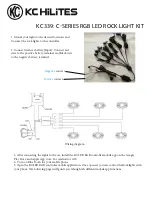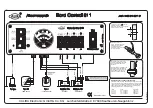
Roof-top air-conditioning system CC4E
Webasto Thermosysteme
Page 12 / 32
Pressure switch
The pressure switch (15, Fig. 2.2) includes a high-pressure and a low-pressure switch. It monitors the
pressure in the high-pressure part of the refrigerant circuit and switches off both the electric motor and the
compressor if the pressure is too low (e.g. due to loss of refrigerant) or too high (e.g. due to overheating in
the condenser).
Anti-icing switch
The anti-icing switch (12, Fig. 2.2) is a temperature switch. It measures the temperature between the
evaporator fins and switches off the power supply to the electric motor if there is any risk of ice forming
(approx. 0 °C) and back on again at approx. 3 °C.
Axial fan
The two axial fans (4, Fig. 2.2) comprise a DC motor, fan wheel, housing and protective grille. When the
air-conditioning system is switched on, they draw a constant supply of power from the on-board system via
relay K1 (Fig. 3.1) and supply the condenser with the required outside air.
Radial fan
The radial fan (5, Fig. 2.2) contains a multi-speed DC motor. It draws the cabin air through the evaporator
and blows the air back into the cabin via the nozzles in the air-distribution panel (Fig. 2.3).
Compressor
The compressor (27, Fig. 2.3) comprises a swashplate compressor and a magnetic coupling with belt pulley.
It is driven at constant speed by an electric motor (28, Fig. 2.2). When in operation, it compresses the
refrigerant to the required condensation pressure.
Electronic room thermostat (optional)
An electronic room thermostat and temperature sensor are integrated in the deluxe version. The intake air
temperature is measured. The electric motor is switched off when the temperature set on the setpoint
potentiometer is reached.
Electric motor
The electric motor (28, Fig. 2.2) drives the compressor via a poly-V-belt. The electronic system in the motor
includes a soft-start function to prevent current peaks being transmitted to the on-board supply. In addition,
the electric motor is switched off automatically in the event of undervoltage (< 20 V for more than 10
seconds) or overload (current consumption > 80 V for more than 1 second) due to possible damage to the
system. It is restarted by repeatedly switching on the system.
The electric motor is switched off automatically to prevent damage to the electronics at temperatures of less
than +5 °C or more than +96 °C.













































